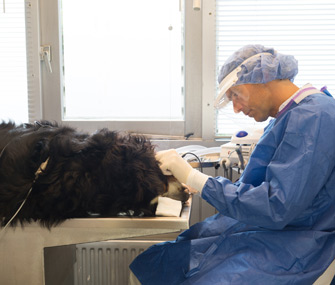Beyond Periodontal Disease: 7 Reasons Your Pet’s Health Demands a Complete Oral Exam
Published on November 02, 2015
Skip To

The best dentists are thorough! So, too, are their veterinary counterparts. After all, there’s more to oral health in pets than managing periodontal disease.
Tough to Examine
Unfortunately, pets tend to be squirrelly about having their mouths opened — much less thoroughly probed. And as much as we may urge pet owners to start brushing their pet’s teeth early on, it’s still the unusual owner who manages to train their pets to surrender complete oral submission. Enter anesthesia. Just ask any veterinarian and they’ll confess: There’s no going without if what you want is a thorough examination.Whether or not you need convincing, this post aims to show you that when mouths go unchecked, pets can suffer in silence from all kinds of painful and serious oral conditions, most of which can’t be a) evaluated or diagnosed properly in the absence of anesthesia and b) treated without it. And many of them go way beyond the garden-variety gingivitis and periodontal disease you may be familiar with.
Oral Conditions Best Caught Early
To help prove my point, I’ve recruited a bunch of common oral conditions that fall into the category of a) painful and b) better off treated earlier than later — most of which demand a complete oral examination.1. Dental fractures. You’d be surprised at how many dental fractures we can uncover once we’ve cleaned all that tartar off those teeth. Slab fractures, in particular (those that split a slice off the side of the teeth), are often hard to identify without a thorough cleaning (one that goes well beyond what a typical anesthesia-free dentistry procedure can offer). Broken teeth can leave the nerves and pulp cavity exposed, creating a portal for bacteria to enter.
2. Feline resorptive lesions. This fancy term applies to very(!) painful lesions that cats tend to suffer at the gumline. Because they often occur at the junction between the root and the crown of a tooth, these cavity-like lesions are sometimes covered by tartar or obscured by gingivitis, which makes them especially hard to identify.
3. Retained roots. In many cases (very commonly in cats who suffer resorptive lesions), catastrophic dental fractures can lead to roots retained beneath the gums. It’s a big deal, since these roots are often painfully infected.
4. Stomatitis. This extremely painful condition, in which the tissues lining the oral cavity become inflamed, tends to be more common in cats. While there are many potential causes, it can occur when gingivitis yields to painful erosion and ulceration, most often around the gums of the least accessible molars. It, too, can be difficult to identify, especially in its earliest stages. Later on, however, this condition becomes so very painful that afflicted pets will often resist any kind of oral examination, which is why anesthesia is so necessary.
5. Dental abscesses. When periodontally diseased teeth become unmoored from their bony attachments, bacteria may colonize the roots of affected teeth. Dental abscessation inevitably results. In many cases this painful condition can go unnoticed for months or even years.
Lucky pets will lose these teeth. Others may see the infection lead to facial swelling and drainage through the side of their faces (typically just under their eye sockets). But most will go unnoticed and untreated without oral evaluation, which typically requires dental X-rays.
6. Oronasal fistulas. These lesions occur most often when the long upper canine teeth become abscessed and the infection bores an opening into the nearby tissues of the nasal cavity. In some cases, nasal discharge and bleeding may result. In others, however, few signs will accompany this often-silent condition.
7. Cancers. Oral cancers can be impressively aggressive, it’s true. However, it’s also true that they start off small. And a great many of these, terrifically aggressive though they might be, are most amenable to treatment when they’re at their earliest stages. Thorough oral evaluations and early identification are crucial to successful treatment.
Aren’t pets amazing? All this pain, infection and discomfort with nary a whine, howl or missed meal. And that’s the point, now, isn’t it? Sometimes serious problems need a serious examination — especially when they live in a location so poorly amenable to evaluation.
More on Vetstreet:
- 10 Ways Your Dog Shows You Love
- Pet Dental 101: Frequently Asked Questions
- 6 Surprising Requests Vets Get From Pet Owners
- Infographic: Why Dogs and Cats Need Dental Care
- 9 Pet Care Expenses You Do NOT Want to Cut Corners on





